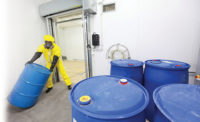Adding basic project management skills to your organization can decrease frustration and increase your safety improvement success rate. Implementing a newly adopted local, state or federal regulation shouldn’t cause panic within your organization — it should start your adopted project management process.
Master the vocabulary
The project management profession has its own unique terminology. When those terms are understood, a project runs more effectively to a successful completion. PMBOK Guide – A Guide to the Project Management Body of Knowledge by the Project Management Institute, defines key terms:Project — a temporary endeavor undertaken to create a unique product, service or result. It has a beginning and an end and requires resources.
Stakeholders — people actively involved in a project or those who can positively or negatively influence it.
Program — a group of related projects managed in a coordinated way.
Project life cycle — a collection of generally sequenced phases specifically identified for that project.
For example, it is a project to implement a new safety procedure in a manufacturing plant. Developing the procedure, obtaining management approval, communication, training and implementation are phases of that project. All of those phases together constitute the life cycle for that project. Multiple improvements could be packaged and managed as a program.
Seize the opportunity
To effectively manage multiple projects you must ensure four basic project characteristics are handled.1) Scope — The final product’s requirements are used to develop the project scope. Scope identifies what is included — and not included — in the project. Scope must be documented early and managed throughout the project life cycle.
2) Cost – The project budget must be approved in conjunction with the scope early in the project life cycle. Project costs must be collected and analyzed against the budget throughout the project life cycle.
3) Schedule — The project’s schedule is developed once the scope, estimates and network diagram are completed and resources have been applied. The schedule should be approved and tracked during the project life cycle.
4) Quality — The quality standards of the project must be established early in the project life cycle, during the requirements definitions stage. The finished product should meet — not exceed — those established quality standards.
The balance of this project management (business) opportunity focuses on four separate categories: people, process, performance and tools.
People
Various studies indicate that 70-80 percent of a project manager’s time and effort involves working with people and their issues. Project management, like the safety profession, requires individuals who can and like to work with people.Individuals should be educated and trained on project management basics prior to being assigned to a project team. There are many sources available for education and training. Recent studies indicate that the number of people working on project teams who have little or no formal training is decreasing. Should this trend continue, project management performance should improve in the future.
One major key to increasing project performance is to “resource load†(schedule the time required for project tasks in accordance with the person’s available time) project team members. For example, does it make sense to quit mowing the lawn halfway through your yard, then wash half of your car, finish the lawn, vacuum the house and then finish washing the car? Of course not. It’s more effective for an individual to remain on a task and complete it before beginning another.
Process
Effectively managing multiple projects requires that each project be properly managed by using a standardized, repeatable project management process. This doesn’t imply that all projects, regardless of scope, be managed the same. Rather, similar projects should have similar well-defined tasks. Stakeholders must understand, use and support the adopted process.In order to improve performance a documented repeatable project management process is necessary, but what is it and where is one found? There are many documented methods available, but the PMBOK‚Guide illustrates one generally accepted method that identifies nine major project management areas: Project Integration, Scope, Time, Cost, Quality, Human Resource, Communication, Risk and Procurement.
Your adopted project management process must be properly managed by limiting the amount of work entering the system, working to established priorities, assigning knowledgeable project managers and, possibly, implementing a project office.
Performance
To ensure the most value for your company, the performance of your project management process, like your safety program, must be continually monitored, analyzed, improved and communicated.Tools
There are multiple tools available to assist your project management efforts. Some of the Microsoft Office products will be helpful. There are also entire project management software packages available. Try to select a tool set that is appropriate for your effort. These tools should complement the primary tool — the adopted project management process.Methods
Here are a few “tricks of the trade†to establish and use a project management process:
An “Implement New Regulation†SOW clearly identifies what other regulations, internal policies and procedures, equipment, training, employees are affected and establishes a clear completion date. The SOW also clearly identifies what the project’s final deliverables are, such as new or rewritten policies and procedures, equipment modifications and required training.
It’s very important to know the delivery criteria for each task — which enables you to know what constitutes complete. An “Implement New Regulation†task — “Analyze New and Other Applicable Regulations†— clearly identifies that task’s objective, deliverable as a written report, required resources (equipment and people), estimated duration, and approval signatures.
SIDEBAR: Take the steps


